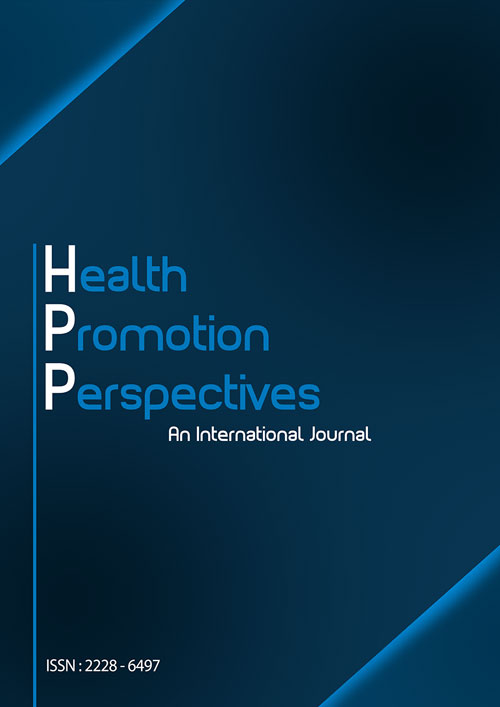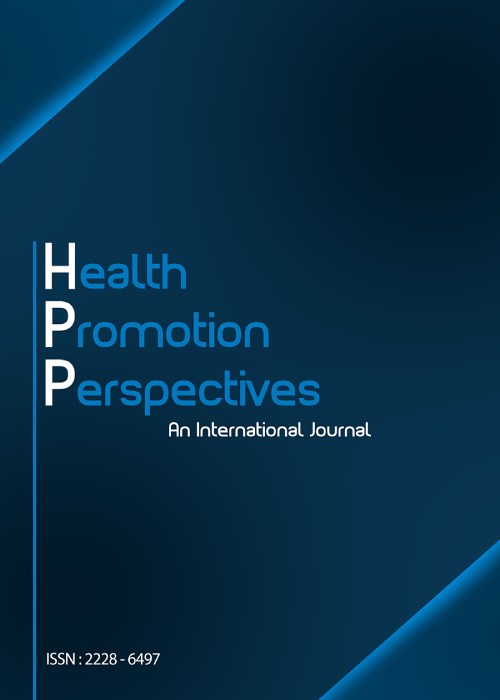فهرست مطالب

Health Promotion Perspectives
Volume:6 Issue: 1, Mar 2016
- تاریخ انتشار: 1395/01/10
- تعداد عناوین: 9
-
-
Pages 1-9BackgroundSchools are the major locations for implementing childrens dietary behavior related educational or interventional programs. Recently, there has been an increase in school-based nutrition interventions. The objective of this systematic review was to overview the evidence for the effectiveness of school-based nutrition intervention on fruit and vegetable consumption.MethodsPubMed was used to search for articles on school-based nutrition interventions that measured students fruit and vegetable consumption. Our search yielded 238 articles. The article was included if published in a peer-reviewed journal, written in English language, administered in the United States, and conducted among a population-based sample of children in Kindergarten through eighth grade. A total of 14 publications met the inclusion criteria.ResultsEight articles successfully showed the positive effect on increasing fruit and or vegetable consumption while the other six did not. Several factors, including (but not limited to) intervention duration, type of theory used, style of intervention leadership, and positively affecting antecedents of fruit and vegetable consumption were compared; however, no dominant factor was found to be shared among the studies with significant findings. Given that the criteria for selection were high, the lack of consistency between interventions and positive outcomes was surprising.ConclusionWith high levels of scrutiny and budget constraints on school nutrition, it is imperative that more research be conducted to identify the effective intervention components.Keywords: Nutrition intervention, Fruit, vegetable consumption, School, Systematic review
-
Pages 10-16BackgroundHealthy Foods, Healthy Families (HFHF) is a fruit and vegetable (F&V) exposure/ incentive program implemented at farmers markets in low-income neighborhoods, targeting families receiving US federal food assistance. We examined program effects on participants diet and associations between attendance, demographics and dietary change.MethodsExposure activities included F&V tastings and cooking demonstrations. Incentives included 40% F&V bonus for electronic benefit transfer (EBT) card users and $20 for use purchasing F&V at every third market visit. Self-report surveys measuring nutritional behaviors/ literacy were administered to participants upon enrollment (n = 425, 46.2% Hispanic, 94.8% female). Participants were sampled for follow-up at markets during mid-season (n = 186) and at season end (n = 146). Attendance was tracked over 16 weeks.ResultsParticipants post-intervention reported significantly higher vegetable consumption (P = 0.005) and lower soda consumption (P = 0.005). Participants reporting largest F&V increases attended the market 6-8 times and received $40 in incentives. No change in food assistance spent on F&V (P = 0.94); 70% reported significant increases in family consumption of F&V, indicating subsidies increased overall F&V purchasing. Participants reported exposure activities and incentives similarly affected program attendance.ConclusionInterventions combining exposure activities and modest financial incentives at farmers markets in low-income neighborhoods show strong potential to improve diet quality of families receiving federal food assistance.Keywords: Obesity, Socioeconomic factor, Diet quality, Farmers markets, Food assistance, Family nutrition intervention
-
Pages 17-22BackgroundThis study was conducted to evaluate working posture of operating room nurses and its relationship with demographic and job details of this group.MethodsThis cross-sectional study was conducted among 147 operating room nurses in Tabriz, Iran using a questionnaire and the Rapid Entire Body Assessment (REBA) checklist. The data were analyzed with SPSS.16 using t test, Pearson correlation coefficient and analysis of variance (ANOVA) tests for univariate analysis and the linear regression test for multivariate analysis.ResultsThe mean (SD) of REBA score was 7.7 (1.9), which means a high risk level and highlights an urgent need to change the working postures of the studied nurses. There was significant relationship between working posture and age (P = 0.003), gender (P = 0.003), regular daily exercise (P = 0.048), work experience (P = 0.003), number of shifts per month (P = 0.006) and type of operating rooms (PConclusionThe findings highlight the need for ergonomic interventions and educational programs to improve working posture of this study population, which can consequently lead to promotion of health and well-being of this group.Keywords: REBA, Postural, Nursing, Healthcare, Iran
-
Pages 23-30BackgroundThe current situation of health promotion (HP) services in hospitals of Iran is unclear. The aim of this study was to assess the status of HP in hospitals in Isfahan, Iran.MethodsThis study is a cross-sectional survey in which 9 educational hospitals selected through census sampling. HP self-assessment was used for the data collection. The assessment teams formed, and evidence examined in line with the tools.ResultsThe results identified five categories of HP activities in the hospitals consisted: patients, staff, environmental, community, and organizational. The mean of total score of HP was 48.8 (9.8). In terms of the HP standards scores, 5 hospitals (55.5%) were at the intermediate level; 3 hospitals (33.3%) were at the weak level, and 1 hospital (11.1%) was at the good level. About the standards, the highest score was information and patient interventions standard 79.8 (13.5), and the lowest was continuity and cooperation standard 36.2 (10.8).ConclusionIt seems that some of the health promoting hospitals (HPS) duties carried out by hospitals. So, to improve the quality of health services, it seems useful to encourage policy makers and health service managers to create coherent policies and guidelines in HPS.Keywords: Health promoting hospitals, Health promotion, Hospital
-
Pages 31-36BackgroundThe present study was conducted to examine the relationship between two dimensions of work-family conflict (WFC) with marital satisfaction and burnout in a society in which few studies have been done about the consequences of WFC.MethodsA cross-sectional study was conducted in 2015. Surveys were distributed to 420 employed married women with various jobs living in Bushehr province, Iran. Data were collected using a questionnaire for demographic characteristic, the Netmeyers WFC questionnaire, Maslach Burnout Inventory: General Survey (MBI-GS), and Enrich marital satisfaction questionnaire. The data were analyzed using descriptive and inferential statistics.ResultsThere was a negatively significant association between work interference with family (WIF) and overall burnout as well as emotional exhaustion (PConclusionIn terms of practical implication, to avoid creating disadvantages of WIF and FIW, facilitation in two domains of improving work and family conditions can be a useful means to prevent WFC and its consequences.
ArticleKeywords: Burnout, Marital satisfaction, Work, family conflict -
Pages 37-41BackgroundThe purpose of this cross-sectional study was to enumerate and describe violent and risky behaviors as well as other general health behaviors exhibited in the advertisements during the National Football League (NFL) Super Bowl 2015.MethodsCommercials during the NFL Super Bowl 2015 were assessed for violent and risky behaviors. Additional health behaviors were indicated such as the advertisement of unhealthy food, promotion of physical activity, and sexual content.ResultsA total of 110 commercials were documented, accounting for 64 minutes of broadcast time. Commercials promoting automobiles, television shows, food, and movies were the most prevalent, representing just over half (53.7%) of all of the advertisements featured. Depictions of unsafe driving were found in 10.9% (n = 12) of the commercials. All 12 commercials contained some sort of risky or wild driving behavior, and speeding was observed in 11 of the 12 commercials. A total of 32 (29.1%) of the commercials were coded as including violent content. Physical activity behavior was present in 3 (2.7%) of the commercials. Conversely, substance use was observed in 3 (2.7%) of the commercials, none of which included health promotion messaging. Of the 110 commercials aired during the 2015 Super Bowl, 12.7% (n = 14) included sexual content.ConclusionParents should consider the possibility that their children may observe acts of violence or conflicting safety messages during commercial breaks.Keywords: Super Bowl, Commercial, Advertising, Television, Violence, Risky behavior
-
Pages 42-46BackgroundRecently, a national breast cancer screening program has been introduced in Iran. The aim of this study was to examine the determinants of breast cancer screening uptake among Kurdish women, in order to identify those characteristics that may be potentially associated with the screening uptakeMethodsThrough a cross sectional study, in 2014, a random sample of 561 women aged 40 years and older without the history of breast cancer and identified with Kurdish background in Baneh county, Iran, were recruited and interviewed by two trained interviewers. Data were collected using a valid and reliable researcher made questionnaire. Univariate and multivariate logistic regression models with self-reported screening history as the dependent variable were used to estimate the odds ratios (ORs) with 95% of CI.ResultsThe mean age of women was 43.64 (SD = 5.17). The participation rate in the mammography program was 16.8% (95% CI: 13.7-19.8%). The lowest level of participation was found among women aged 60 and older (OR = 0.30, 95% CI: 0.14-0.69), illiterate (OR = 0.63, 95% CI: 0.40-0.99) and post-menopausal (OR = 0.56, 95% CI: 0.35-0.91) women.ConclusionIt was found that the level of breast screening uptake was low among Kurdish women compared to those reported in the previous studies. Designing participation enhancing interventions with a specific focus on older, illiterate and post-menopausal women are recommended.
ArticleKeywords: Breast cancer screening, Socioeconomic status, Determinants, Minority, Iran -
Pages 47-53BackgroundLeisure time is one of the most important aspects of life, especially for people with chronic diseases. The concept and types of leisure have frequently been evaluated in different socio-cultural populations. The aim of this study was to identify the nature of leisure activities among a sample of Iranian patients with multiple sclerosis (MS) and classify the identified types of activities in the context of Iranian culture.MethodsIn this qualitative study, semi-structured interview was applied to gather data from 34 MS patients that were selected through purposive sampling. The interviews were continued up to the point of saturation. Content analysis was used to explore experiences of the interviewees regarding their leisure activities.ResultsSix categories of leisure activities were extracted for the studied patients with MS i.e. physical, social, individual, art/cultural, educational and spiritual/religious.ConclusionThe results represented the range and heterogeneity of leisure activities amongst the MS patients. Considering participation in spiritual/religious and social activities as leisure time undertaking might reflect cultural diversity in the perception and use of time for recreation. For mental health promotion purposes, paying special attention to the types of activities that people of different socio-cultural background choose for their refreshment could help health care providers in giving tailored advice for patients with MS and other chronic debilitating disease.Keywords: Leisure activities, Multiple sclerosis, Qualitative study


